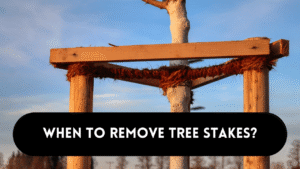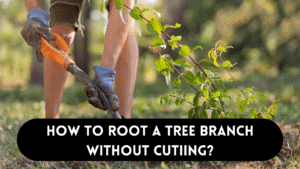Mistletoe, with its festive associations, may seem charming, but it can be a severe threat to the health of our trees. This parasitic plant attaches itself to tree branches, drawing nutrients and water from the host tree, which weakens it over time. To prevent further damage and preserve the tree’s health, it’s crucial to remove mistletoe before it produces seeds and spreads to other limbs or nearby trees.
How to Remove Mistletoe from Trees
1. Pruning for Mistletoe Removal
Pruning is the most common method for removing mistletoe from trees. Proper pruning is essential to ensure that the mistletoe is entirely eradicated and doesn’t grow back.
- Pruning at least 6 inches below mistletoe growth: When pruning, make sure to cut at least 6 inches below the mistletoe-infested area. This ensures that you remove the entire mistletoe plant, including the roots.
- Cutting back to the branch collar or secondary branch: To help the tree recover from the pruning process, make clean cuts back to the branch collar or to a secondary unit. This promotes proper healing and reduces the risk of infection or disease.
- Removing all mistletoe inside and outside the tree: Mistletoe can spread from one part of the tree to another, so it’s vital to remove all visible mistletoe growth both inside and outside the tree canopy.
2. Assessing Tree Health and Infestation Levels
Before deciding on the best approach to mistletoe removal, it’s essential to assess the tree’s overall health and the extent of the mistletoe infestation.
- Removal of unhealthy and older trees with heavy infestations: If the tree is already weakened or old and the mistletoe infestation is extensive, removal of the tree may be the best option. This prevents the mistletoe from spreading to other trees and preserves the health of nearby plants.
- Considering multiyear controls and treatments for tree health: In some cases, especially for younger or healthier trees, it may be possible to implement multiyear controls and treatments to improve the tree’s health while gradually removing the mistletoe.
- Justifying the use of a certified arborist: Assessing the tree’s health and deciding on the best course of action can be challenging. Engaging the services of an accredited arborist ensures expert guidance and professional care.
3. Using a Certified Arborist for Safe Removal
Engaging the services of a certified arborist offers several advantages, ensuring the safe and effective removal of mistletoe from trees.
- Preventing harm to the tree during mistletoe removal: Certified arborists possess the necessary expertise to remove mistletoe without causing damage to the tree’s structure or health.
- Expertise in handling large pieces of wood without damaging tree health: When removing larger branches infested with mistletoe, a certified arborist knows how to perform cuts that promote healing and minimize stress on the tree.
- Benefits of professional services: Arborists have access to specialized equipment and techniques that make mistletoe removal more efficient and thorough.
4. DIY Pruning Techniques
If you choose to tackle mistletoe removal on your own, follow these steps for safe and effective pruning.
- Steps for safely removing mistletoe by yourself: Start by wearing appropriate safety gear, including gloves and eye protection. Use sharp and clean pruning tools to make precise cuts.
- Cutting infested material back to the branch collar: When pruning, make sure to cut back to the branch collar to avoid leaving stubs, which can attract pests and pathogens.
- Tools and equipment needed for the process: Invest in quality pruning shears and loppers for smaller branches and a pruning saw for larger ones. Having a sturdy ladder is essential for reaching higher branches safely.
5. Ideal Conditions for Mistletoe Removal
Timing and environmental conditions play a crucial role in the success of mistletoe removal.
- Ensuring complete wetness of mistletoe leaves: For practical herbicide application, it’s essential to ensure the mistletoe leaves are entirely wet. This allows the herbicide to penetrate the plant effectively.
- Timing the removal before the host tree has leafed out: The ideal time for mistletoe removal is during the dormant season before the host tree starts producing new leaves. This reduces the risk of injuring the tree during the pruning process.
- Recommended temperature conditions for effective removal: A temperature of around 65°F (18°C) is ideal for mistletoe removal, as it allows for proper herbicide absorption and tree recovery.
Preventive Measures to Minimize Mistletoe Infestation
Preventing mistletoe infestations is crucial for maintaining tree health. Here are some preventive measures to consider:
- Regular Tree Maintenance: Maintain proper tree health through regular watering, fertilization, and pruning. Healthy trees are more resistant to mistletoe infestations.
- Sanitation Practices: Promptly remove any mistletoe-infested branches and debris from your property to prevent the spread of seeds to other trees.
- Monitoring Nearby Trees: Keep an eye on neighboring trees, as mistletoe can spread from one tree to another. Take action if you notice signs of infestation in nearby trees.
Mistletoe Removal and Its Impact on Wildlife
While mistletoe removal is vital for maintaining tree health, it’s also important to consider its impact on wildlife. Mistletoe serves as a valuable food source for certain birds and insects, contributing to the ecological balance of our ecosystems. Many bird species, including the mistle thrush and various types of warblers, depend on mistletoe berries for sustenance during the winter months when other food sources might be scarce.
When planning mistletoe removal, it’s worth considering the potential disruption to local wildlife. Removing mistletoe can temporarily affect birds and insects that rely on its berries for nourishment.
To mitigate this impact, you can provide alternative food sources for these creatures, such as bird feeders with nutritious seeds or suet. Additionally, maintaining diverse plant life in your landscape can help support a variety of wildlife species even after mistletoe removal.
Striking a balance between tree health and the needs of local wildlife is crucial. While mistletoe removal helps preserve the vitality of our trees, finding ways to support the animals that depend on mistletoe can contribute to a more harmonious and thriving ecosystem overall.
Herbicide Application for Mistletoe Removal
Using herbicides for mistletoe removal is an option that requires careful consideration and responsible application. Herbicides can effectively control mistletoe growth when used correctly, targeting the mistletoe without causing harm to the host tree or surrounding plants.
It’s important to choose a selective herbicide formulated specifically for mistletoe control. These herbicides are designed to impact mistletoe without affecting the host tree’s health. When applying herbicides, follow the manufacturer’s instructions meticulously, ensuring the correct dosage, application method, and timing.
Before using herbicides, assess the extent of the mistletoe infestation and the overall health of the tree. In cases of severe infestations or weakened trees, it might be more prudent to consult a certified arborist to determine the best course of action. They can provide expert guidance on whether herbicide application is suitable for your situation and implement it safely if appropriate.
When utilizing herbicides, consider their potential impact on the environment. Choose products that are environmentally friendly and biodegradable. Applying herbicides in a responsible manner, while taking into account the tree’s health and the surrounding ecosystem, ensures the most effective results without causing harm to non-target organisms.
Common Misconceptions About Mistletoe Removal
Several misconceptions exist about mistletoe removal. It’s important to clarify these to ensure proper tree care:
- Misconception: Mistletoe can be removed by simply cutting off the visible part.
- Reality: Removing only the visible portion doesn’t eliminate the entire mistletoe plant, as its roots extend into the tree’s vascular system.
The Role of Tree Selection in Mistletoe Prevention
Choosing the right tree species for your landscape can play a significant role in preventing mistletoe infestations:
- Resistant Species: Research and select tree species that are less susceptible to mistletoe infestations. Some trees are naturally more resistant than others.
- Native Trees: Opt for native tree species that have evolved alongside local parasites and may have developed defense mechanisms against mistletoe.
Educating Your Community: Spreading Awareness
Raising awareness about the harmful effects of mistletoe infestations and proper removal techniques can have a positive impact on your community:
- Workshops and Seminars: Organize workshops or seminars to educate neighbors, friends, and fellow garden enthusiasts about mistletoe removal and prevention.
- Social Media and Online Platforms: Utilize social media platforms and gardening forums to share information, success stories, and tips related to mistletoe removal.
- Collaboration with Arborists: Partner with certified arborists to conduct educational sessions and demonstrations on mistletoe removal at local community events.
Long-Term Landscape Management for Mistletoe Prevention
Maintaining a mistletoe-free landscape requires ongoing efforts and considerations:
- Regular Monitoring: Continuously monitor your trees for signs of mistletoe regrowth or new infestations.
- Scheduled Pruning: Incorporate regular tree pruning into your landscape management routine to remove potential mistletoe hosts before infestations take hold.
- Landscape Design: Plan your landscape layout with mistletoe prevention in mind. Maintain adequate spacing between trees to minimize mistletoe’s ability to spread.
People Also Ask
Can mistletoe removal save a heavily infested tree?
In cases of severe infestation or weakened trees, mistletoe removal may not fully save the tree. Consult a certified arborist to assess the situation and recommend the best course of action.
Can mistletoe spread from one tree to another?
Yes, mistletoe can spread from an infected tree to nearby healthy trees through birds that consume mistletoe berries and then deposit the seeds on other branches or trees.
Are there any bird-friendly alternatives to mistletoe during the holidays?
Holly, ivy, and evergreen branches are popular alternatives to mistletoe as festive decorations while providing shelter and food for birds during winter.
Can mistletoe removal be done year-round?
Mistletoe removal is most effective during the dormant season before trees start producing new leaves. However, if you’re dealing with a severe infestation, consult an arborist for guidance on the best removal timing.
Conclusion
Removing mistletoe from trees is a critical step in maintaining the health and longevity of our beloved trees. Whether you choose to prune the mistletoe yourself or engage the services of a certified arborist, following the proper techniques and timing ensure the most effective results. By taking action to remove mistletoe and implementing preventative measures, we can protect our trees and maintain the beauty of our landscape for generations to come.




